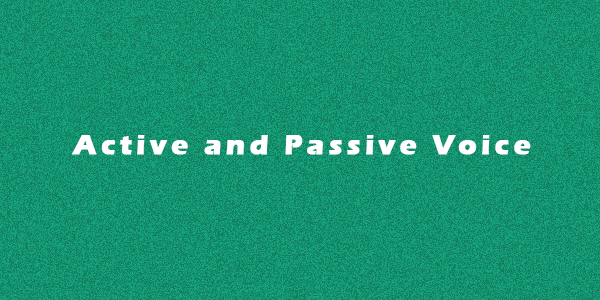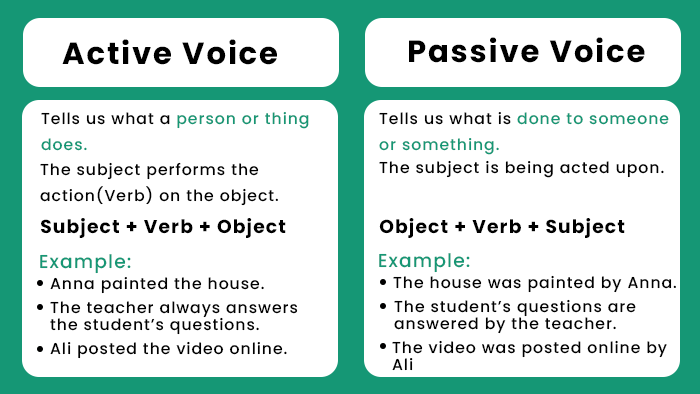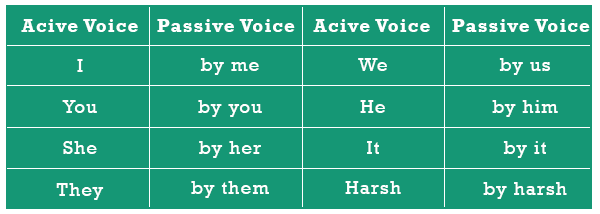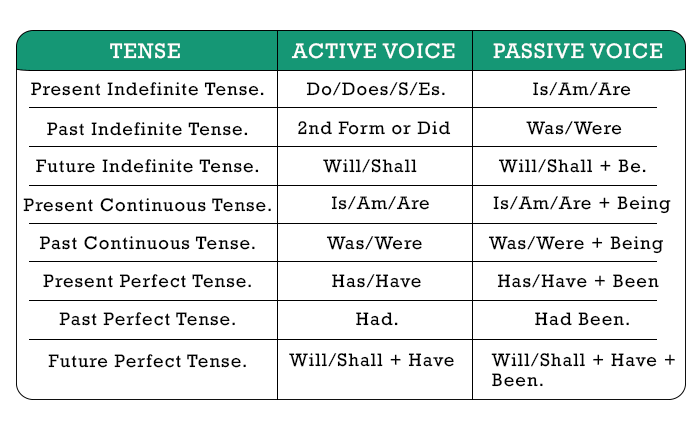Active and Passive VoiceConsider the sentence "I like a smoothie." It's simple and straightforward?you can tell right away that the subject, I, desires an object, a smoothie. Rewrite this sentence such that the object gets in the place of the subject: "Smoothie is liked by me." It's not just lengthier, but it's also more disconnected, twisted, and difficult. 
These two statements demonstrate the active and passive voices. Certain types of writing are more suited to the active voice, while others are better suited to the passive voice. Knowing when, how, and why to employ each is important to become a good author and speaker. Subjects carry out the activity in a sentence, making it active (and simple and easy to comprehend). But what if the subject comes after the action or is totally absent from a sentence? Then you have a passive sentence, and you may need to change it based on what you're writing. Passive vs. Active VoiceThe active voice characterizes a sentence where the subject executes the actions. In the sentence "Sarah congratulated Davies," for example, Sarah (the subject) performs the verb (congratulated), and Davies (the object) receives the action. It follows a simple subject + verb + object structure. The subject follows after the verb in the passive voice. For instance, in "Davies was congratulated by Sarah," Sarah is not doing the verb even though she is the one providing the congratulation. Passive voice causes structural complexity for the reader; active voice allows you to be more direct. 
What Is the Distinction Between Active and Passive Voice, And What Are Their Various Functions?In the active voice, the subject is doing an action The kitty chases the mouse. Take note of how the subject, kitty, executes the action, chase, on the objective of the action, mouse. This is a straightforward instance of the active voice. In the case of passive voice, the action's goal, the mouse, is placed first as the focal of the sentence. The sentence is inverted, and the verb then acts on the subject. To say it in a different way, the subject is passive: The mouse is being chased by the kitty. English Grammar comprises two voices: active and passive. Both of them have their own characteristics and uniqueness; neither is better in comparison to the other. Both are equal, and each is particularly suitable for certain writing styles. Journalists or reporters, at times, seem disconnected from the places/ circumstances they are reporting due to a common reason: they often use the passive voice. While the opinionated articles and authors seem too specific as they employ an active voice in their writings. However, the concept of professors urging their pupils to skip using the passive voice has become so common that it sounds like a cliché. The truth is that the passive voice also has its uses. For the time being, let's look at detecting the active and passive voice in your writing or other writings. Active VoiceAs we've seen, the subject of the sentence executes the action in the active voice. Here are two statements written in the active voice:
Writing in the active voice means constructing your sentence so that the subject executes the verb, regardless of whatever verb you employ. The tone of the active voice is straight and distinct. When you desire the reader to emphasize the subject of your sentence and the act it is doing instead of the objective of the action, use it. Passive VoiceThe goal of the activity or action is focal of the passive voice, and the verb works on the subject. Every statement in the passive voice has two verbs:
Consider the following instances, now written in passive voice:
Take note in the above examples that the targets of the activity-along with the direct objects of the sentences-have shifted into the spotlight. They now include a conjugated version of "to be" (is) and the past participle of the primary verb (enjoyed and loved). Sentences in the passive voice are frequently longer than statements in the active voice since they must incorporate additional words such as prepositions. Consider the below-mentioned sentence in the passive voice: Summertime is [conjugated form of the verb "to be"] liked [past participle of the main verb] by [preposition] my kids. On the other hand, sentences expressed in the passive voice do not always require a preposition. Consider the following example sentences :
The tone of the passive voice is more delicate than that of the active voice. This tone is appropriate when you desire your audience to emphasize the action being narrated or the action's goal instead of who or what is doing the action. This is the reason passive voice is employed in laboratory reports: it portrays scientific neutrality by reducing the emphasis on the person doing the act. Use Of Active and Passive VoiceWe always hear that passive voice writing is "poor writing," but the reality is more complicated. The active voice is a more practical approach for explaining the ideas, concepts, and information you convey in all forms of writing. These include emails, blogs, and various kinds of essays. However, in certain kinds of writing, the passive voice is essential. Consider how typical criminal and incidential reports are prepared and delivered:
The passive voice is employed in these reports to highlight the activity that happened instead of the individual or team who did the crime, which is common when the offender is unknown or has not yet been proven guilty of the crime. Other types of writing emphasize the activity rather than the person performing it. Scientific and, in certain circumstances, historical reports are among them. These employ the passive voice to retain the reader's attention on what has occurred or is occurring. Here are a couple of such examples:
Take note of how the perpetrator of the action is not named in either of these phrases. This is because it is either inferred or unimportant. The scientist experimenting is the one who placed the mice in the tunnel in the first case. In the second, people in charge of the presidency event have no bearing on what is being communicated in the sentence. How to Change Sentences from Passive to Active VoiceAlways read it when you've finished your initial draft. You should also read it loudly and listen to how it sounds. You can catch problematic sentences and imprecise language by reading it aloud or making someone else read and you hearing it. This is followed by marking them as sections to edit in your subsequent draft. You will also be able to understand where you employed active or passive voice and how it has affected the overall tone of your writing.
Notice how these statements are revolving around the subject and rather than looking into it directly? The writer isn't making an especially compelling case, but they can improve the effectiveness of their writing by switching to the active voice. Determine who or what is executing the activity sentence by sentence, and try making that the subject when you restate it. Make educators the subject of the first line since they are the ones performing the activity or act. In this statement, the main verb is received, and the aim is more versatile booking options, which will serve as the direct object in your new sentence. After you've found these, rewrite the sentence so that the subject is directly executing the verb. This sentence would be written in the active voice as follows: Educators receive more versatile booking options. Notice how this version is short and to the point? It helps the author in appearing more assured, which is important in an argumentative write-up. Change the second sentence to the active voice, which enables us to make it simple: Trainees pay a signification amount of fees every year, and many believe they are not getting the quality of service they are compensating for. As the compound sentence mentioned above shows, one can write any type of statement in the active or passive voice as far as it contains a transitive verb. You may radically change the tone of a statement by merely rewriting its structure, be it is a simple or complicated sentence (or even a compound-complex sentence). If you're not sure if a sentence is active or passive depending on how it sounds, apply the principles mentioned above to distinguish the two voices in your writing. The most obvious sign that it is a passive voice sentence is a form of "to be" accompanied by past participles (e.g., was discussed or was remembered). Not that every passive voice sentence specifies who is doing the activity, but if it does, it is followed by a preposition (e.g., by educators or by my sister). When paraphrasing a longer text, you can use any voice. You may need to utilize the passive voice in your modified version in some circumstances, such as when rewording a scientific paper. In some cases, paraphrasing in an active voice may actually help to clarify the original. 
Rules For Transitioning from Active to Passive VoiceIt is quite simple to switch from active to passive voice; simply follow the below-mentioned rules;
When Should You Use Passive Voice?Believe it or not, there are situations when using the passive voice is appropriate - even preferred. Passive voice is acceptable to readers and editors when :
What Are the Uses Of Passive Voice?1. Passive voice is utilized when the activity or the job needs to be known. In such a case, by is used in the passive voice. For instance, 'Earth Song' is sung by Michael Jackson. 2. Also, this voice is utilized when the perpetrator's work doesn't need to be known. For instance, The Garden is cleaned every evening. 3. Passive voice is utilized if we desire to know more about the activity than the subject who is performing. For instance, A new mall is constructed. 4. This voice is utilized if we forget who the perpetrators' activity/ task. For example- The criminal was murdered. 5. Passive voice is also utilized to avoid awkward sentences or wrong grammar. For instance, When he arrived home, cops arrested him. However, it is better to say, 'When he arrived home, he was arrested by the cops. ' Rules for Transitioning Passive to Active VoiceTo convert a statement from passive to active voice, follow the below-mentioned rules:
Active and Passive Voice ExamplesHere are some active and passive voice samples to help you grasp the information above: Active: People play cards on Diwali. Passive: Cards are played on Diwali. Active: They revamped the mansion in 2020. Passive: The mansion was revamped in 2020. Active: Sanya decorated the balcony yesterday. Passive: The balcony was decorated yesterday. 
Tenses and VoicePresent Tense- Use the simple present tense to generalize, describe a state of being, or imply a habitual or repetitive action. Active- I make paintings. Passive- Paintings are made by me. Structure- Subject + auxiliary verb + past participle of the main verb+ by + object. Present Continuous- Use the present progressive to express a continuing activity or a one-time action. Active- I am devouring a meal. Passive- A mean is being devoured by me. Subject + auxiliary verb + being + by + object is the structure. Present Perfect- Use this tense for expressing an activity that occurred in the past. However is important to or extends to the present. Active- I have completed the puzzle. Passive- The puzzle has been completed by me. Structure- Subject + has/have been + past participle + by + object. Use the simple past to represent a general or habitual behavior that occurred in the past or at a specific moment in the past. Active- I welcomed you to the group. Passive- You were welcomed by me to the group. Structure: Subject+ be+ past participle+ by+ object QuestionsActive- Did you provide me the costume ? Passive- Was I provided the costume by you ? Past Progressive- Use the past progressive to show a continuing action in the past or action that continues through a specified past time. Active- I was learning computer games. Passive- Computer games were being learned by me. Structure: Subject+ auxiliary verb + being+ past participle + by +object Past Perfect- Use the past perfect to describe a completed action that occurred before a specific period or before another action in the past. Active- You had completed the task. Passive - The task had been completed by you. Subject+ had+ been+ past+ participle + by + object Future Tense- Use the future to signify an action that will occur in the future. Active- He will win the final. Passive- The final will be won. Subject+ will+ be+ past+ participle+ by+ object is the structure. Future Perfect Tense Active- you will have initiated the assignment. Passive- The assignment will have been initiated by you. The subject shall/will have been the past participle by subject. It is essential to keep in mind that future continuous and perfect continuous tenses do not produce passive voice. The more you practice, the more you will grasp the concept of switching from active to passive and passive to active voice. |
 For Videos Join Our Youtube Channel: Join Now
For Videos Join Our Youtube Channel: Join Now
Feedback
- Send your Feedback to [email protected]
Help Others, Please Share










